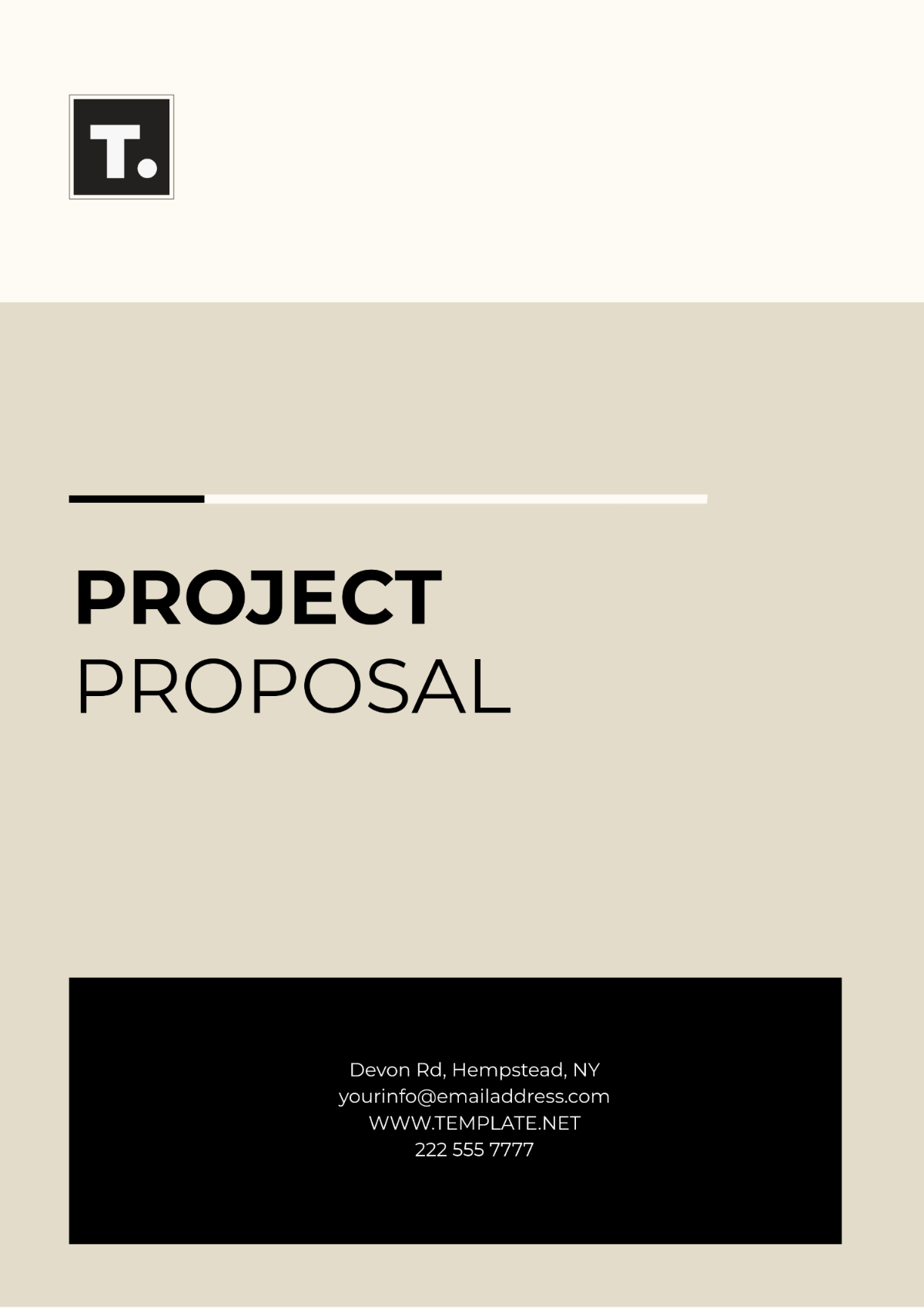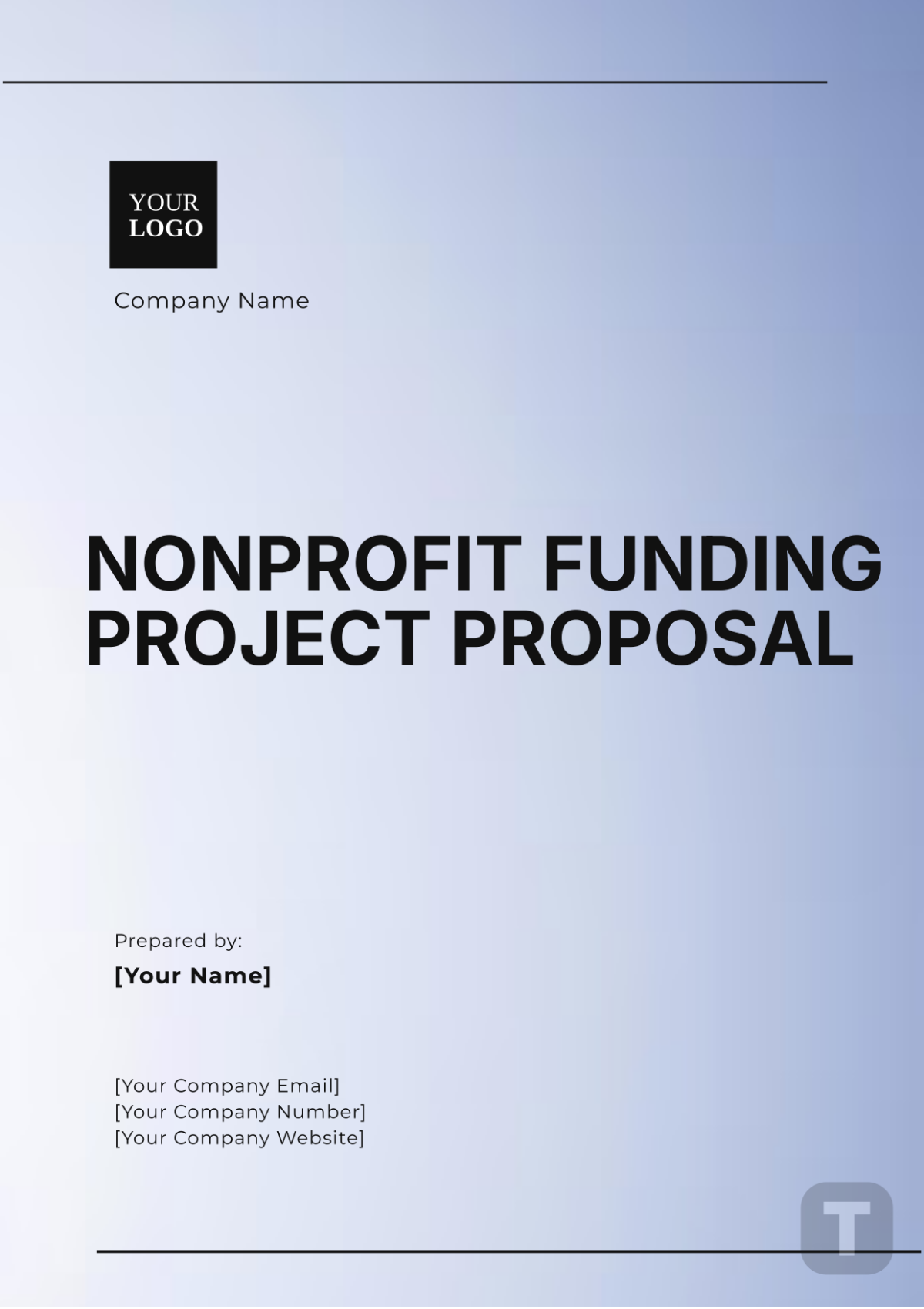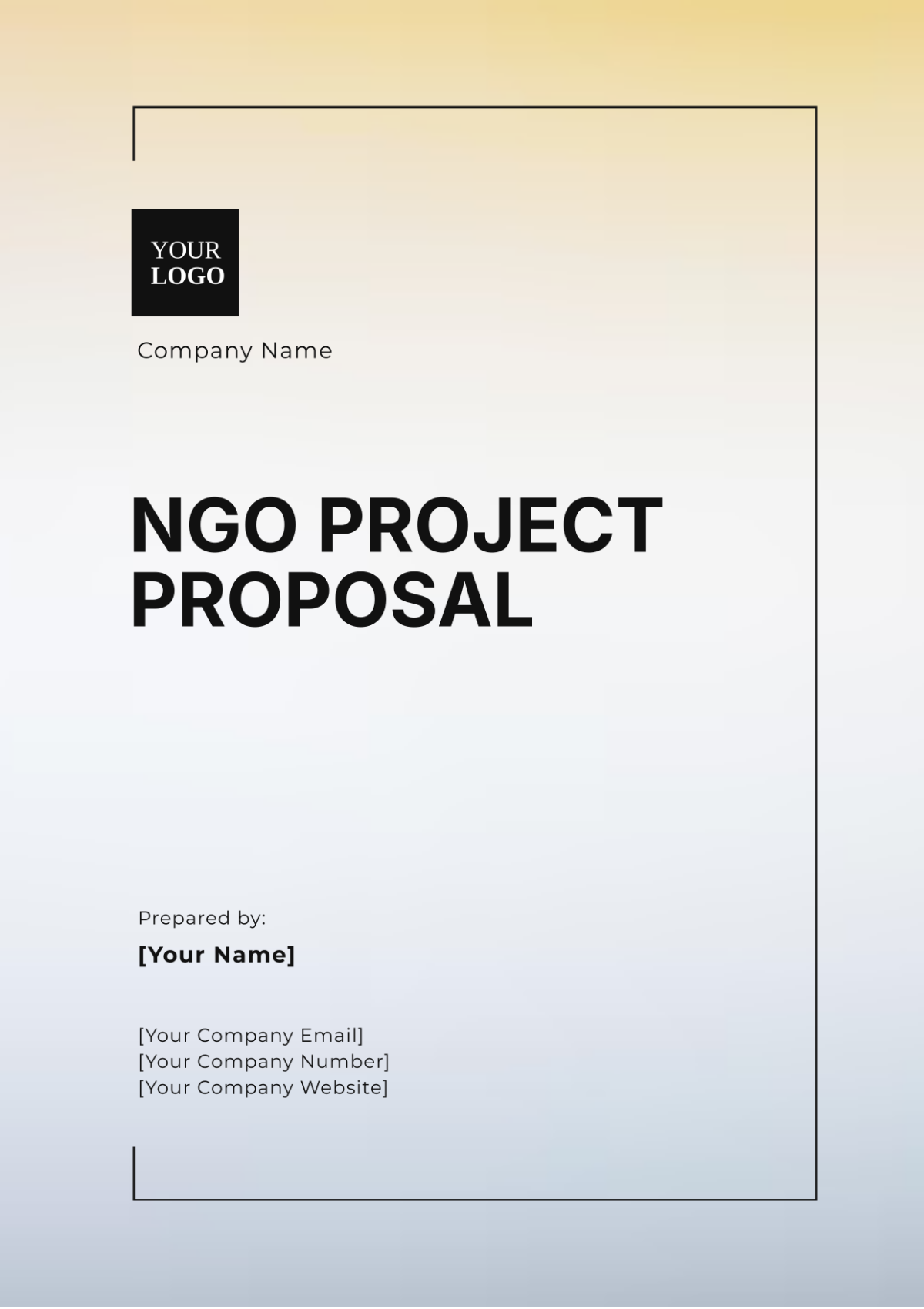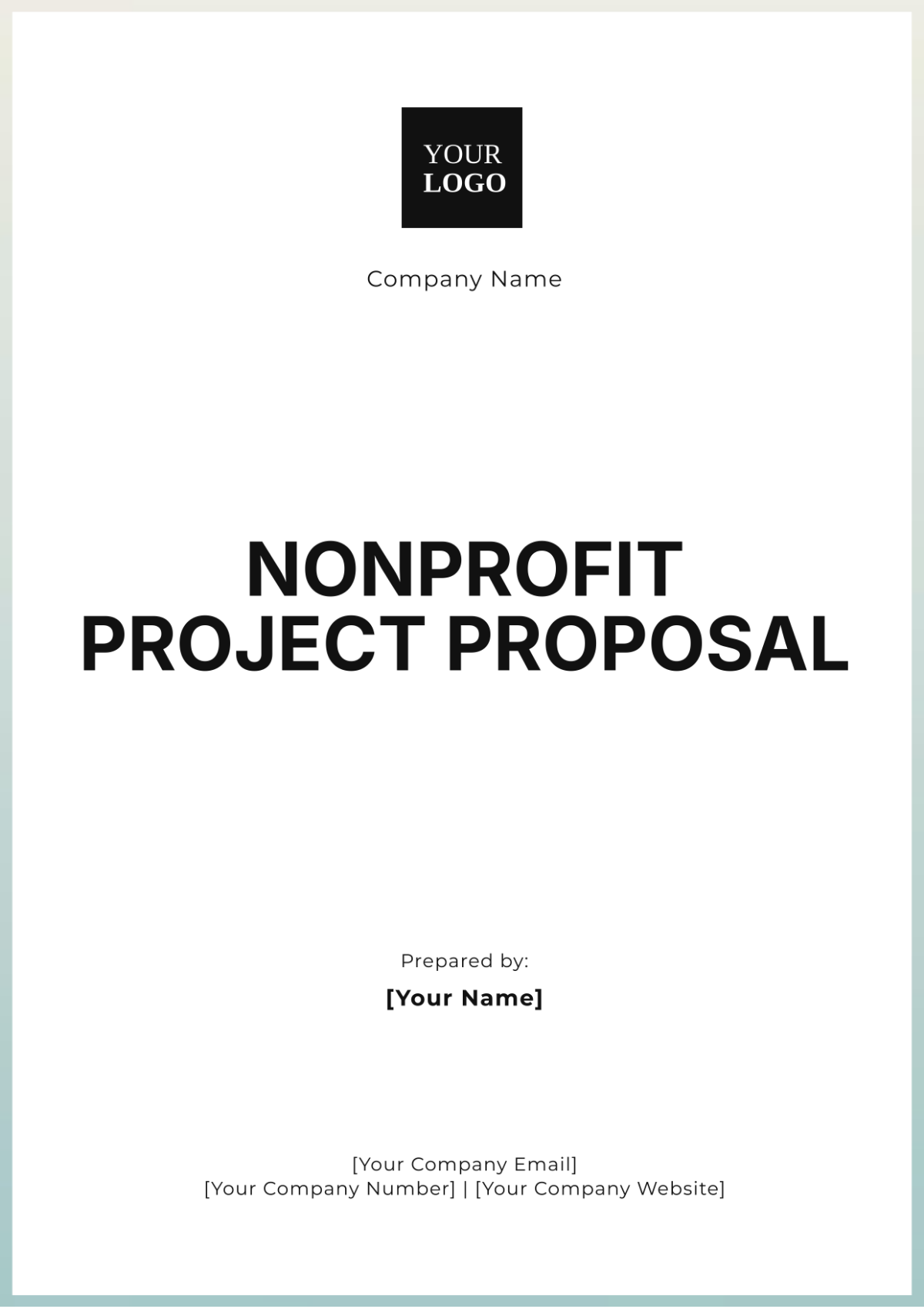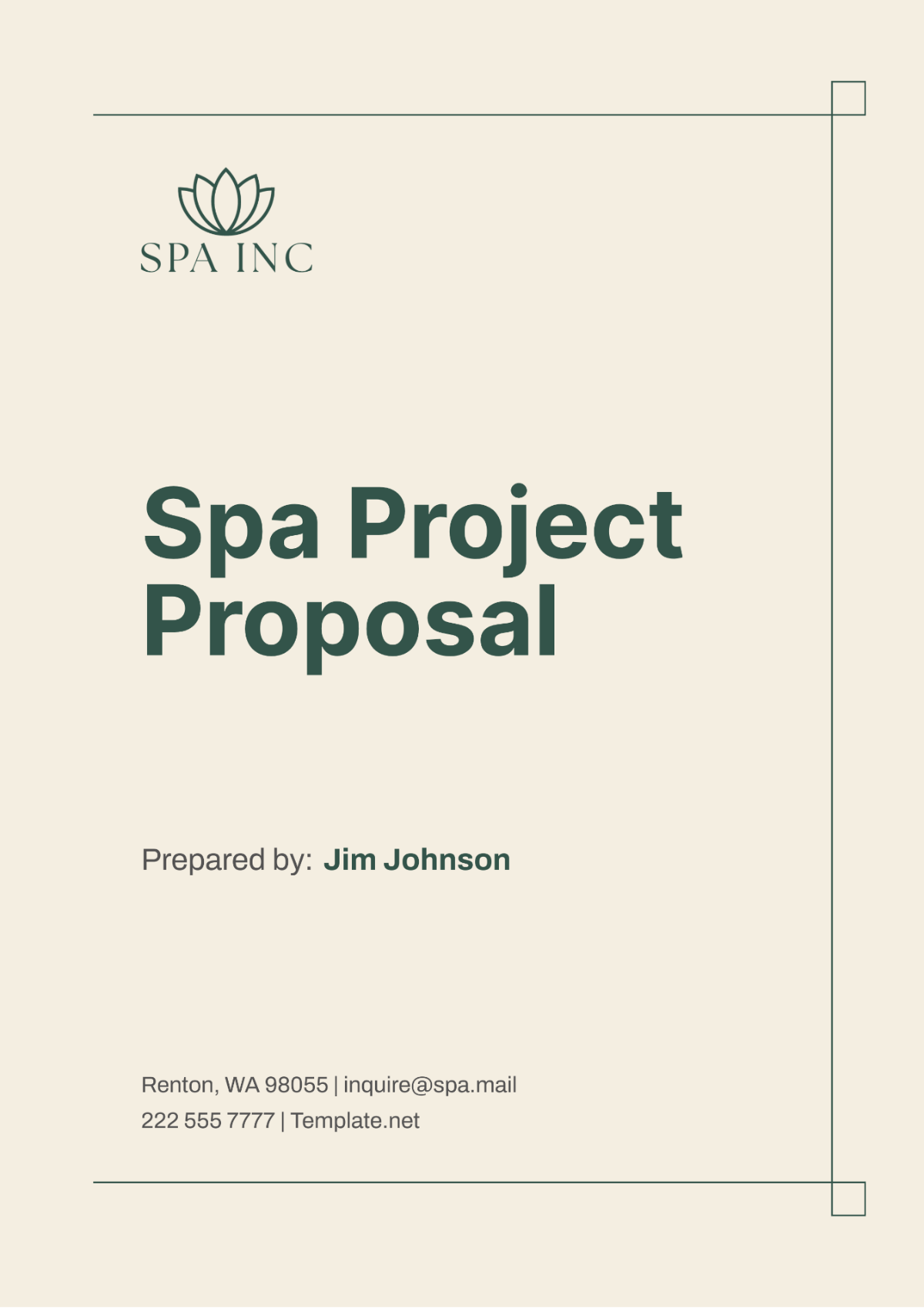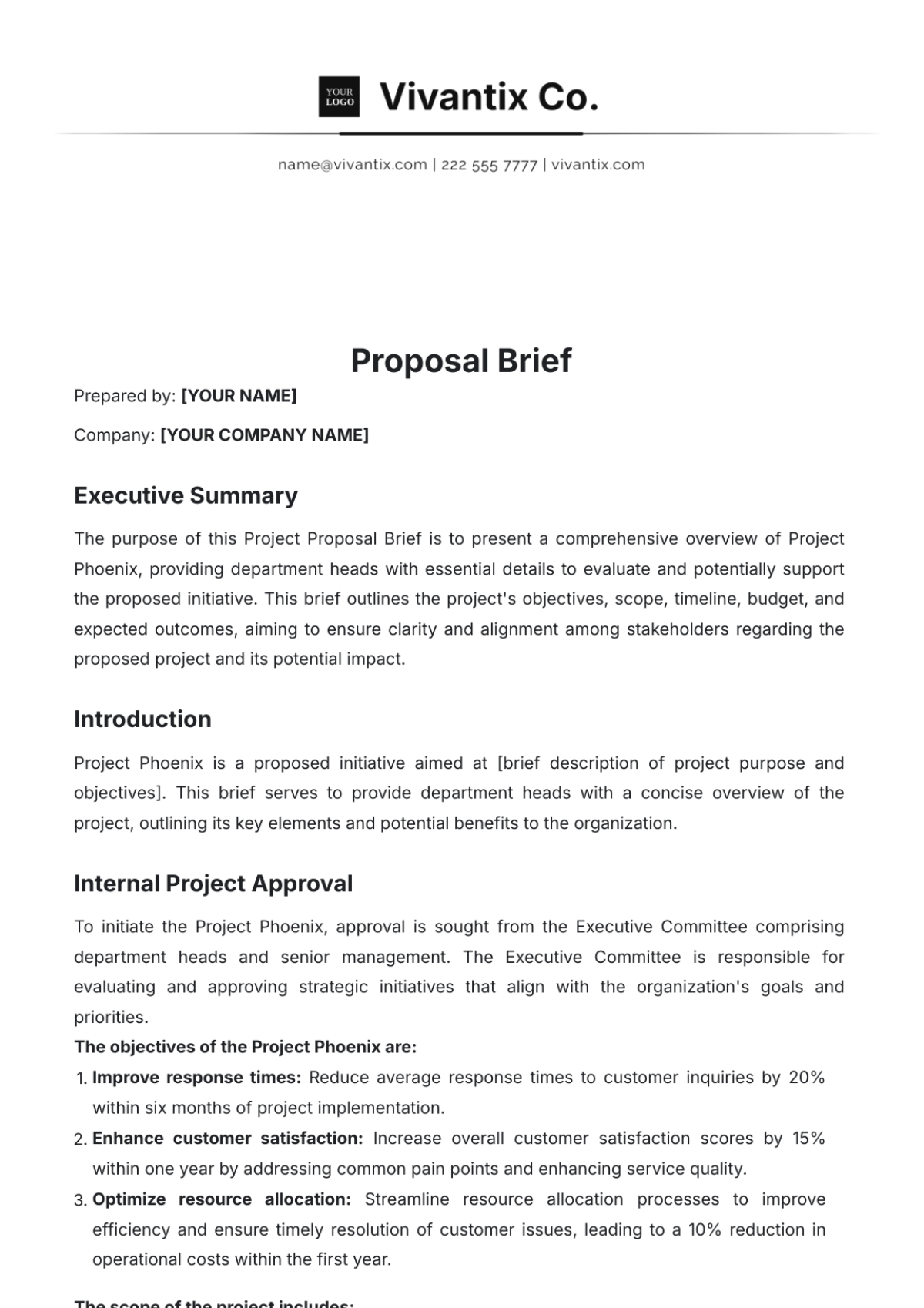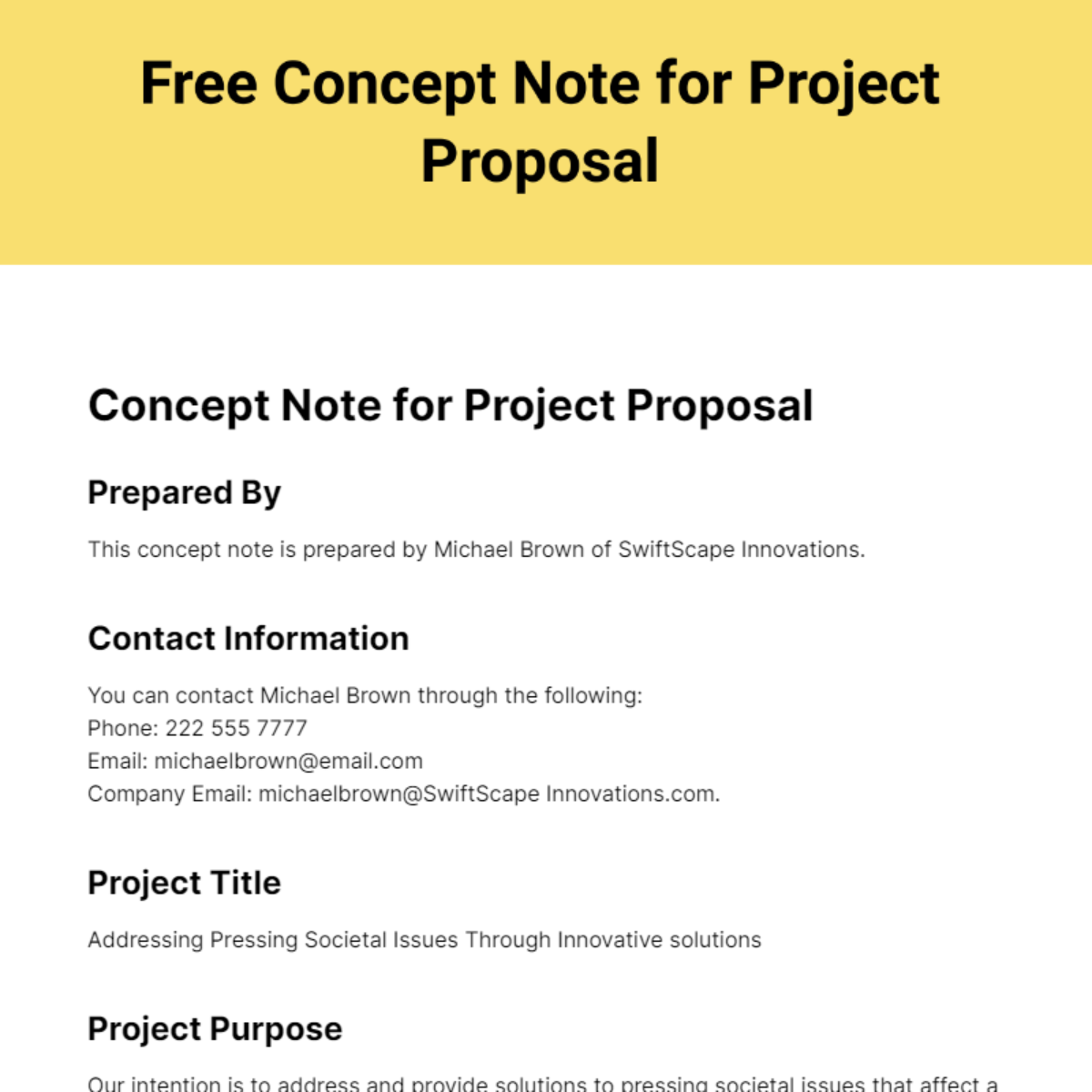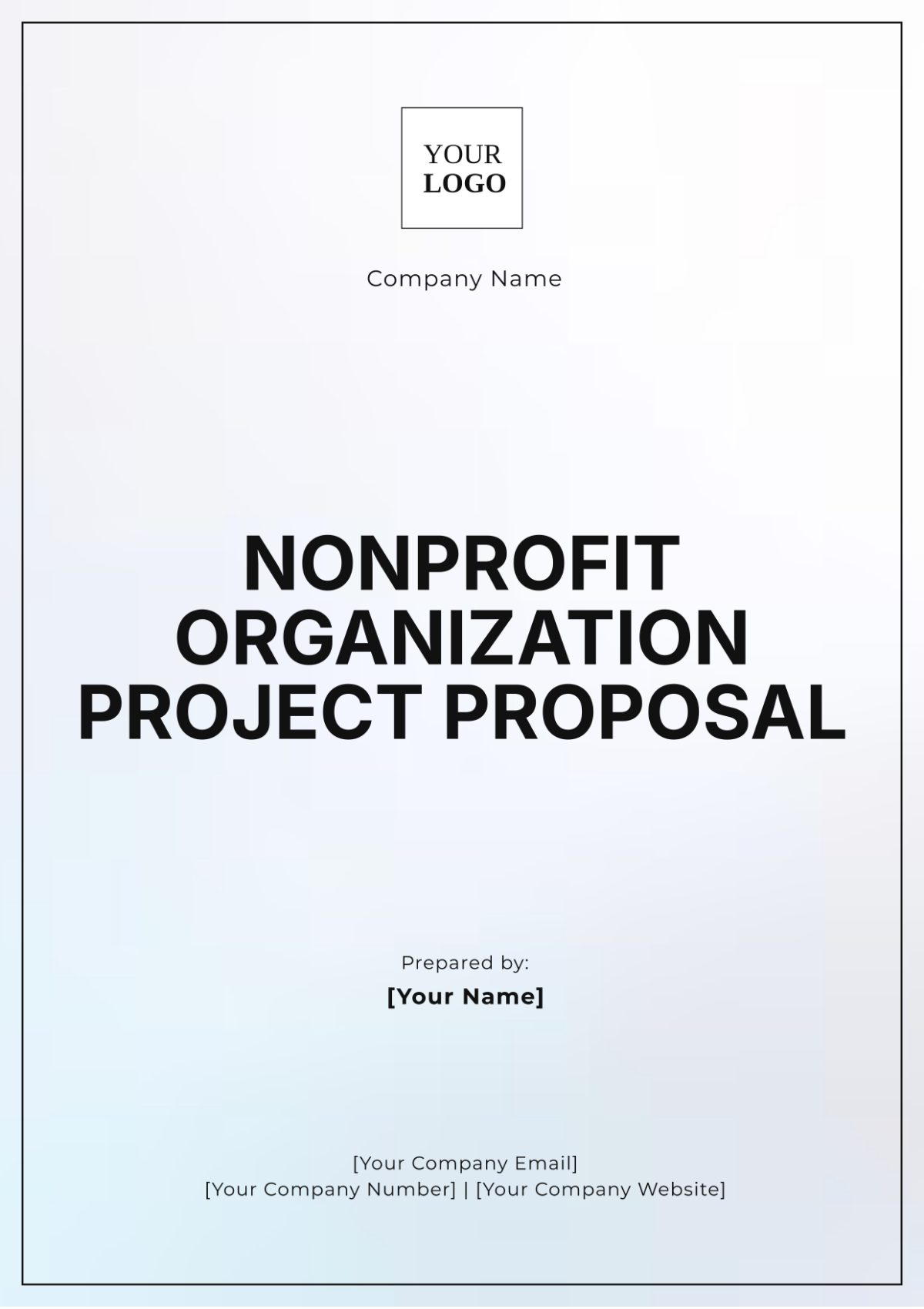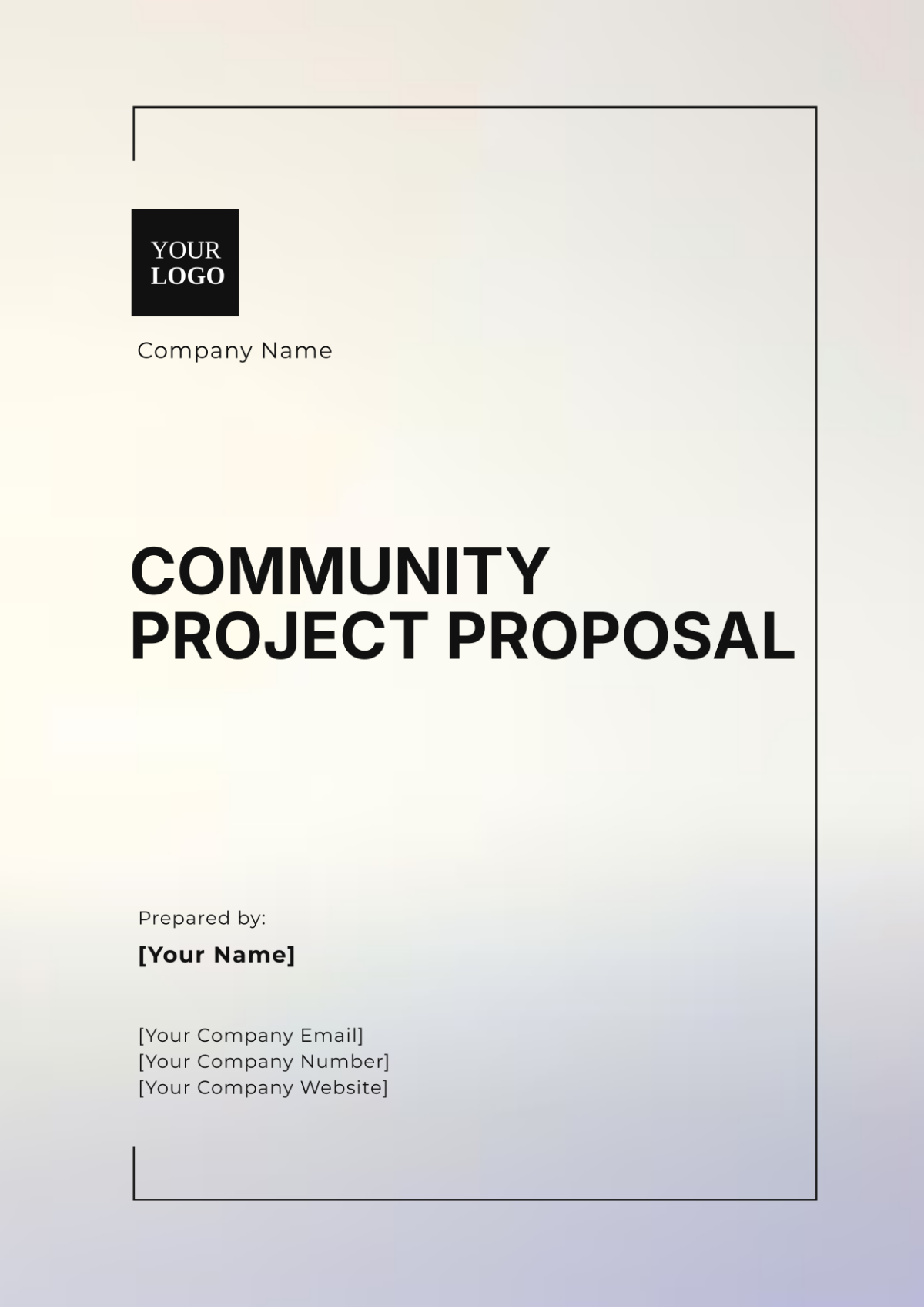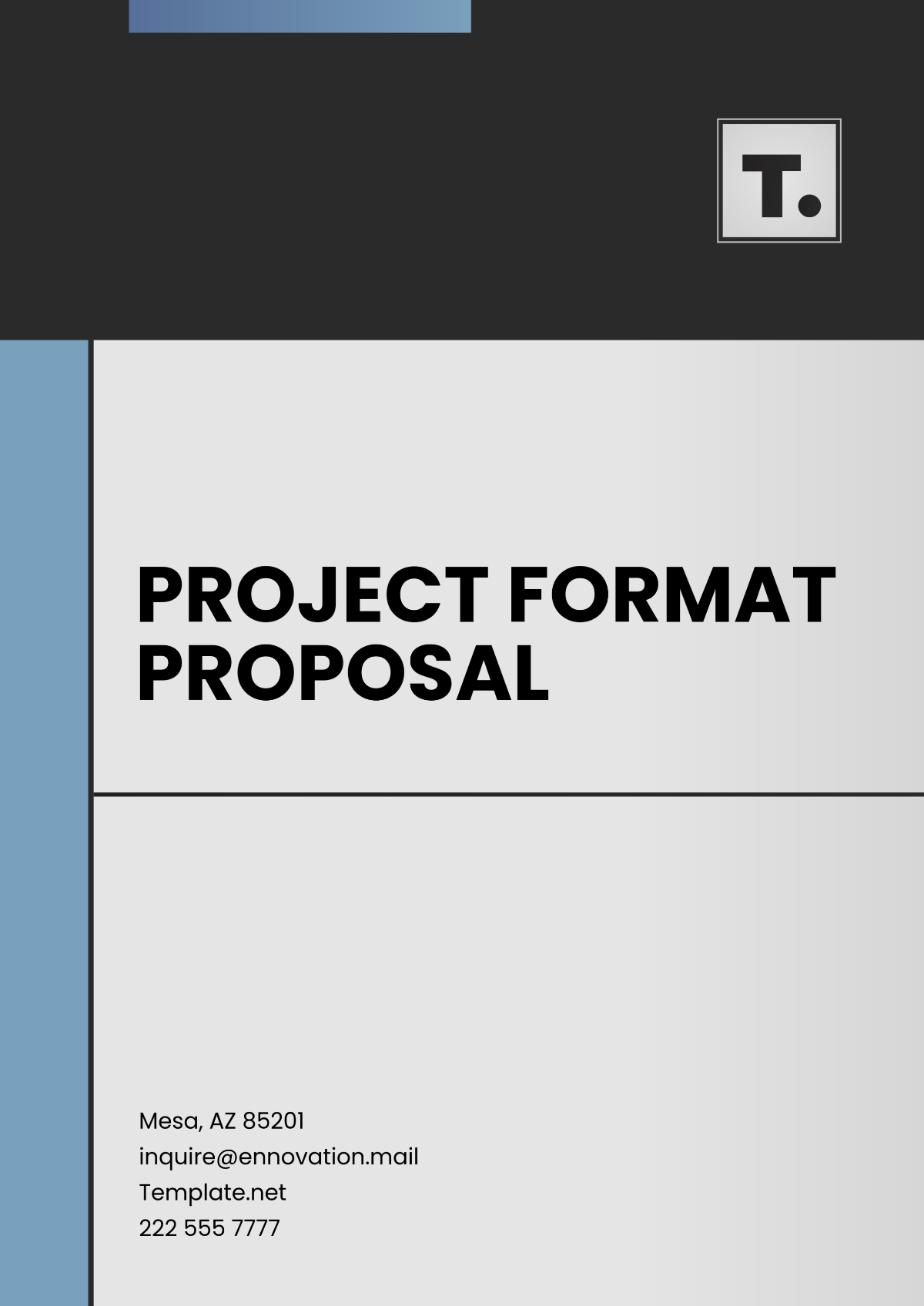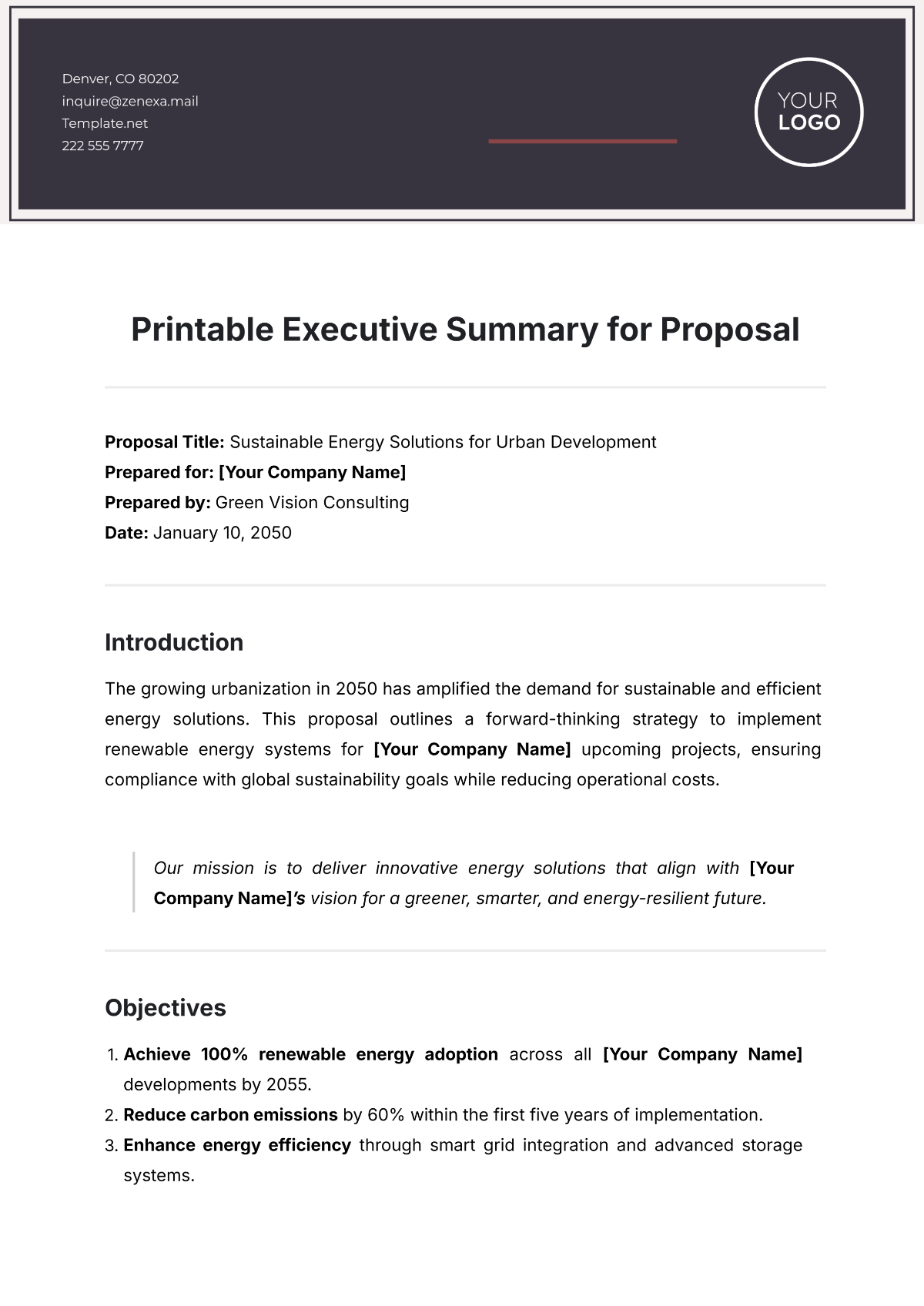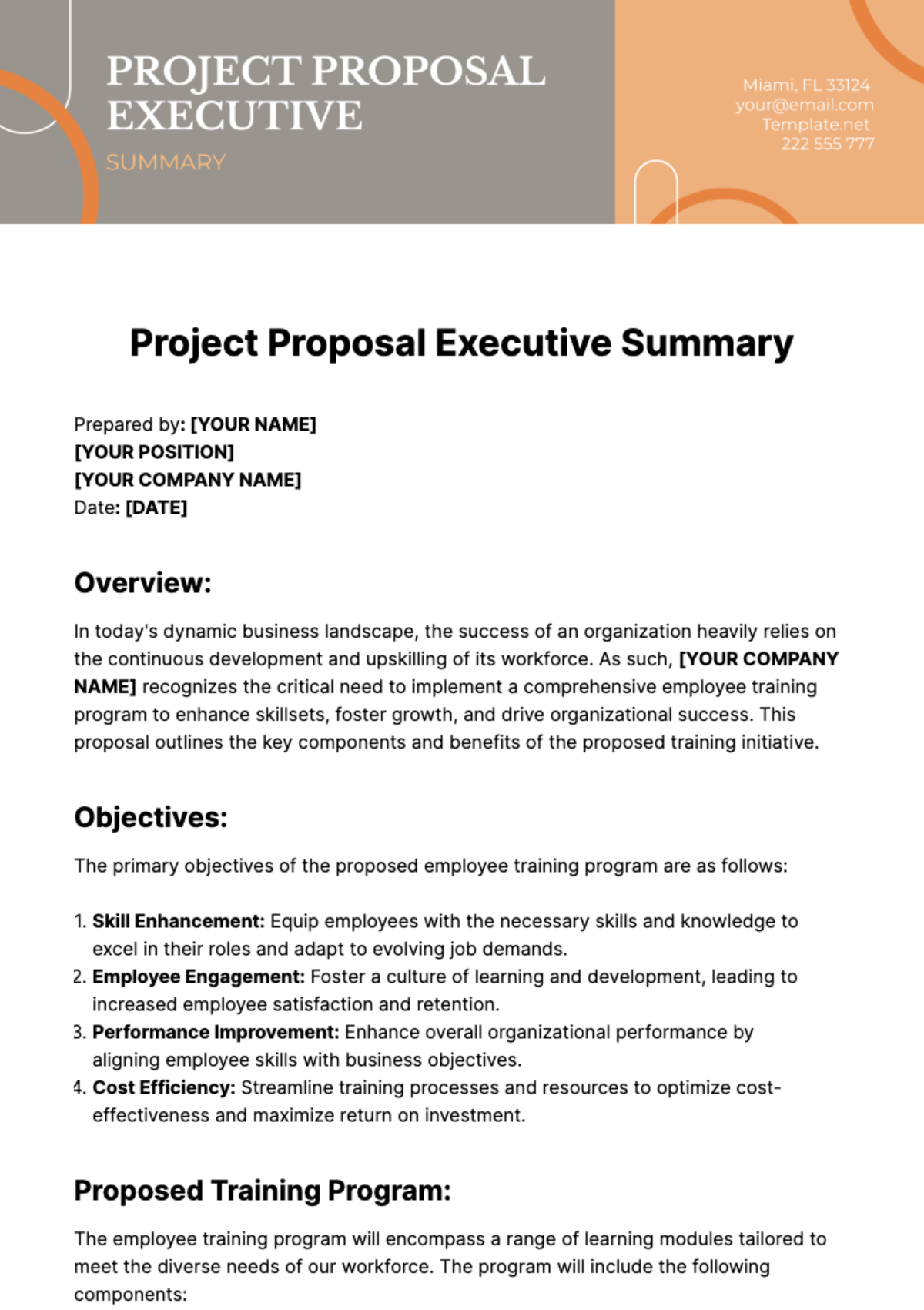Proposal Brief
Prepared by: [YOUR NAME]
Company: [YOUR COMPANY NAME]
Executive Summary
The purpose of this Project Proposal Brief is to present a comprehensive overview of Project Phoenix, providing department heads with essential details to evaluate and potentially support the proposed initiative. This brief outlines the project's objectives, scope, timeline, budget, and expected outcomes, aiming to ensure clarity and alignment among stakeholders regarding the proposed project and its potential impact.
Introduction
Project Phoenix is a proposed initiative aimed at [brief description of project purpose and objectives]. This brief serves to provide department heads with a concise overview of the project, outlining its key elements and potential benefits to the organization.
Internal Project Approval
To initiate the Project Phoenix, approval is sought from the Executive Committee comprising department heads and senior management. The Executive Committee is responsible for evaluating and approving strategic initiatives that align with the organization's goals and priorities.
The objectives of the Project Phoenix are:
Improve response times: Reduce average response times to customer inquiries by 20% within six months of project implementation.
Enhance customer satisfaction: Increase overall customer satisfaction scores by 15% within one year by addressing common pain points and enhancing service quality.
Optimize resource allocation: Streamline resource allocation processes to improve efficiency and ensure timely resolution of customer issues, leading to a 10% reduction in operational costs within the first year.
The scope of the project includes:
Implementation of a new customer relationship management (CRM) system to centralize customer data and streamline communication channels.
Training and development programs for customer service representatives to enhance their skills in problem-solving, communication, and conflict resolution.
Introduction of self-service options for customers, such as an online knowledge base and chatbot support, to provide immediate assistance and reduce reliance on human intervention.
Expected outcomes of the Project Phoenix are:
Decreased response times: Customers will experience quicker resolution times for their inquiries, leading to improved satisfaction and loyalty.
Increased customer satisfaction: By addressing pain points and providing more efficient service, overall customer satisfaction scores are expected to rise, contributing to long-term customer retention and brand loyalty.
Cost savings: Streamlining resource allocation processes and leveraging technology to enhance efficiency will result in reduced operational costs and improved profitability for the organization
Funding Requests
To adequately fund Project Phoenix, external investment or sponsorship may be required. This section outlines the project's value proposition, anticipated returns on investment, and how the funds will be utilized to achieve the stated objectives, inviting potential investors or sponsors to support the initiative.
Utilization of Funds:
The funds raised will be allocated strategically to ensure the efficient execution of Project Phoenix. A breakdown of budget allocation includes:
Category | Percentage Allocation |
|---|---|
Personnel | 40% |
Technology and Equipment | 25% |
Research and Development | 20% |
Marketing and Promotion | 10% |
Contingency | 5% |
Partnership Opportunities
Collaboration with external entities presents a strategic opportunity to enhance the success and impact of Project Phoenix. By leveraging the resources, expertise, and networks of other organizations or research institutions, Project Phoenix can achieve its objectives more efficiently and effectively. The following are specific partnership opportunities identified for consideration:
Industry Partnerships: Establishing partnerships with industry leaders or relevant businesses can provide access to specialized knowledge, technology, or market insights that complement the goals of Project Phoenix. By collaborating with industry partners, we can enhance the relevance and applicability of project outcomes, ensuring alignment with market needs and trends.
Academic Collaborations: Engaging with academic institutions offers access to cutting-edge research, talent, and intellectual resources. Collaborating with universities or research centers can enrich the development process of Project Phoenix, fostering innovation and contributing to the advancement of knowledge in relevant fields. Additionally, academic partnerships may open avenues for securing funding or grants to support project activities.
Nonprofit Organizations: Partnering with nonprofit organizations or advocacy groups aligned with the objectives of Project Phoenix can amplify its social impact and outreach. By leveraging the existing networks and community relationships of nonprofit partners, we can enhance project visibility, engagement, and sustainability, ultimately benefiting the target audience or beneficiaries of the project.
Government Agencies or NGOs: Collaboration with government agencies or non-governmental organizations (NGOs) can provide access to regulatory insights, funding opportunities, and infrastructure support essential for project implementation. By aligning with the goals and initiatives of relevant governmental or non-governmental entities, Project Phoenix can navigate regulatory challenges more effectively and leverage available resources to maximize its impact.
International Partnerships: Exploring international partnerships offers opportunities to access diverse perspectives, resources, and markets beyond our local context. Collaborating with international organizations, research institutions, or businesses can facilitate knowledge exchange, market expansion, and cross-cultural learning, enriching the outcomes and sustainability of Project Phoenix.
Stakeholder Engagement
Engaging relevant stakeholders is a critical aspect of ensuring the success of Project Phoenix. The following strategies will be employed to effectively engage stakeholders, including internal teams, clients, and end-users, throughout the project lifecycle:
Identification and Analysis: A comprehensive stakeholder analysis will be conducted to identify all individuals or groups who have a vested interest in the project. This analysis will assess their level of influence, interest, and potential impact on the project's outcomes.
Clear Communication Channels: Transparent and open communication channels will be established to facilitate regular updates, progress reports, and information sharing with stakeholders. This will include scheduled meetings, email updates, and an accessible project portal or platform for sharing relevant documents and resources.
Tailored Engagement Approaches: Recognizing that different stakeholders may have varying levels of involvement and interests in the project, engagement approaches will be tailored to meet their specific needs and preferences. This may include targeted communications, one-on-one meetings, focus groups, or workshops, as appropriate.
Active Feedback Mechanisms: Opportunities for stakeholder feedback will be integrated into the project's communication plan to ensure that their perspectives and concerns are heard and addressed promptly. Feedback mechanisms may include surveys, suggestion boxes, or designated contact points for providing input.
Alignment with Stakeholder Objectives: Efforts will be made to align the project's goals and objectives with the priorities and objectives of key stakeholders. This will involve engaging stakeholders early in the planning process to understand their expectations and incorporate their input into project planning and decision-making.
Continuous Engagement: Stakeholder engagement will be an ongoing process throughout the project lifecycle, not just a one-time activity. Regular check-ins and progress reviews will be scheduled to keep stakeholders informed and engaged, allowing for adjustments to be made based on evolving needs and priorities.
Feasibility Studies
Before progressing with the implementation of Project Phoenix, thorough feasibility studies are imperative to assess its viability and mitigate potential risks. These studies delve into various critical aspects to ensure informed decision-making. The following key considerations are evaluated:
Technical Feasibility:
Assessment of technological requirements and capabilities necessary for project execution.
Evaluation of existing infrastructure, equipment, and technical expertise available within the organization.
Examination of potential technological constraints or challenges that may impact project feasibility.
Financial Feasibility:
Estimation of the initial investment required to initiate the project, including equipment, manpower, and any other resources.
Analysis of projected costs throughout the project lifecycle, considering expenses such as procurement, development, maintenance, and operational costs.
Evaluation of potential revenue streams, cost savings, or other financial benefits that the project may generate.
Operational Feasibility:
Examination of the operational processes and workflows impacted by the project implementation.
Assessment of the organization's capacity to integrate the project into existing operations without disrupting ongoing activities.
Identification of potential operational challenges or constraints that may arise and their potential impact on project success.
Risk Assessment:
Identification and analysis of potential risks and uncertainties associated with the project, including technical, financial, and operational risks.
Development of risk mitigation strategies to address identified risks and minimize their impact on project outcomes.
Evaluation of contingency plans to manage unforeseen challenges or deviations from the initial project plan.
Legal and Regulatory Compliance:
Assessment of legal and regulatory requirements applicable to the project, ensuring compliance with relevant laws, regulations, and industry standards.
Identification of any potential legal or regulatory obstacles that may impede project implementation and mitigation strategies to address them.
Project Planning and Execution
Upon approval, detailed project planning and execution efforts are initiated. This section provides an overview of the project's implementation roadmap, including deliverables, timelines, budget allocation, and resource management strategies, guiding project managers and team members throughout the execution phase.
The following provides specific information regarding the project's planning and execution:
Implementation Roadmap: A comprehensive implementation roadmap will be developed to outline the step-by-step process for executing Project Phoenix. This roadmap will include key milestones, tasks, and dependencies to guide project managers and team members throughout the execution phase.
Deliverables: The project deliverables will be clearly defined, outlining the specific outcomes and products that will be produced as part of Project Phoenix. Deliverables will be aligned with the project objectives and will be measurable to track progress and success.
Timelines: A detailed timeline will be established to schedule activities and allocate resources effectively throughout the project lifecycle. This timeline will include start and end dates for each phase of the project, as well as deadlines for key deliverables and milestones.
Budget Allocation: The project budget will be allocated based on resource requirements, including personnel, materials, equipment, and any external services or contractors needed for the project. Budgetary constraints and cost estimates will be carefully considered to ensure efficient use of resources.
Resource Management Strategies: Effective resource management strategies will be implemented to optimize the allocation and utilization of resources throughout the project. This includes identifying and assigning roles and responsibilities to team members, as well as monitoring and adjusting resource allocation as needed to address any challenges or changes in project scope.
Risk Management Plan: A comprehensive risk management plan will be developed to identify, assess, and mitigate potential risks that may impact the successful execution of Project Phoenix. This plan will outline strategies for risk avoidance, mitigation, transfer, or acceptance to minimize the impact of uncertainties on project outcomes.
Communication Plan: A communication plan will be established to ensure clear and transparent communication among project stakeholders, including team members, department heads, sponsors, and other relevant parties. This plan will define communication channels, frequency, and protocols for sharing project updates, progress reports, and any issues or concerns that arise during the execution phase.
Conclusion
In conclusion, Project Phoenix presents an opportunity to [briefly reiterate project benefits]. This Project Proposal Brief aims to facilitate informed decision-making and garner support from department heads for the successful initiation and execution of the proposed project.
